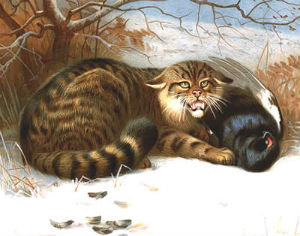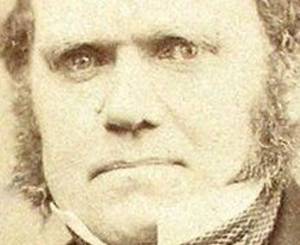Domestic Cat × Wildcat
Felis catus × Felis silvestris
Mammalian Hybrids
|
|
EUGENE M. MCCARTHY, PHD GENETICS

|
| Scottish wildcat (Felis silvestris) with black grouse carcass, as illustrated by Archibald Thorburn (1902). |
These cats come into potential breeding contact in much of Eurasia and Africa. The hybrids are partially fertile in both sexes. The IUCN (Internet Citations: WILDC) says that
Extensive hybridization occurs in Scotland where feral domestic cats have been present for more than 2,000 years. Legislation to protect the Scottish wildcat has been ineffective because an expert witness in court was unable to distinguish wildcats from hybrids (Balharry and Daniels 1991). Beaumont et al. (2001, pp. 334-335) state that
Similarly, Yamaguchi et al. 2004 found intense hybridization not only in Scotland, but also in S. Africa. They concluded (p. 339) “that where a population is heavily introgressed, the only feasible way to define a wildcat is on the basis of inter-correlated features and conservationists must take a population-based approach to assess the extent of introgression. This approach may provide an operational standard for assessing the impact of hybridisation between wildcats and domestic cats throughout the species’ range; it suggests that the Scottish wildcats may be critically endangered.” There are reports, too, of extensive, long-standing hybridization elsewhere in Europe (particularly in Hungary), as well as in Africa and Asia.

|
| Charles Darwin |
Apparently such hybridization has long been recognized since Darwin (1883, vol. 1, p. 30) notes that
Darwin also mentions interbreeding between domestic cat and types formerly treated as species, but now as races of F. silvestris, i.e., F. ornata (India) and F. lybica (northern Africa), F. caffra (southern Africa). Regarding caffra, he says (p. 31) says, “In South Africa as Mr. E. Layard informs me, the domestic cat intermingles freely with the wild F. caffra; he has seen a pair of hybrids which were quite tame and particularly attached to the lady who brought them up; and Mr. Fry has found that these hybrids are fertile."
An interesting aspect of this cross is that it provides an example of how early writers considering a cross often assert without basis that the cross is impossible, even though the cross later turns out to be extremely common. Thus, Bell (1837, p. 179) entirely dismissed the idea that these two cats might interbreed: “The assertion, so often repeated, that the Wild and the Domestic Cat will breed together, I believe to be absolutely without foundation.”
A list of cat crosses
The following is a list of reported cat crosses. Some of these crosses are much better documented than others (as indicated by the reliability arrow). Indeed, some might seem completely impossible. But all have been reported at least once. The links below are to separate articles. Additional crosses, not listed here, are covered on the cat hybrids page.
|
|
By the same author: Handbook of Avian Hybrids of the World, Oxford University Press (2006).
Publications consulted: Ackermann 1898; Antonius 1951b; Biro et al. 2005; Blyth 1863b (p. 184); Daniels et al. 2001; French et al. 1988; Hamilton 1896; Hemmer 1968a; International Zoo Yearbook 1966 (p. 396), 1967 (p. 312); Jerdon 1874 (p. 111); Lecis et al. 2006; McMaster 1871 (p. 222); Nowell and Jackson 1996; Peters 1932; Pierpaoli et al. 2003; Pitt 1938; Pocock 1907; Puzachenko 2002; Randi 2003; Randi et al. 2001; Spassov et al. 1997; Stahl and Artois 1995; Tomkies 1991; Yamaguchi, Driscoll, et al. 2004; Yamaguchi, Kitchener, et al. 2004. Internet Citations: MESS2; PETD.
Most shared on Macroevolution.net:
Human Origins: Are we hybrids?
On the Origins of New Forms of Life
Mammalian Hybrids
Cat-rabbit Hybrids: Fact or fiction?
Famous Biologists
Dog-cow Hybrids
Georges Cuvier: A Biography
Prothero: A Rebuttal
Branches of Biology
Dog-fox Hybrids